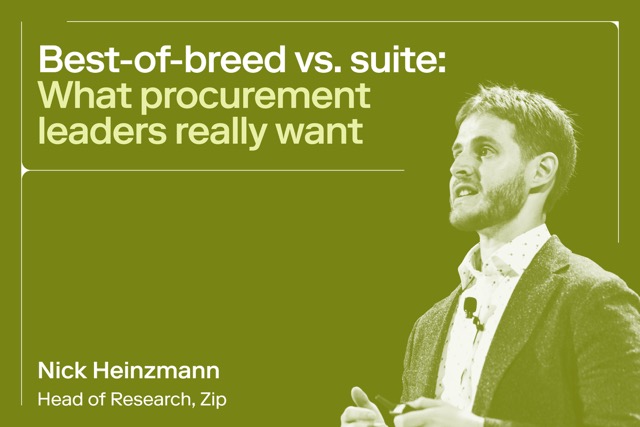
How to build a successful procurement strategy in 8 steps
Learn to create a procurement strategy that maximizes value for your business.

Whether there’s a defined strategy or not, every company does procurement.
From onboarding new SaaS platforms to acquiring office supplies, businesses need to do business to do business. However, without a strategic approach, procurement can be a nightmare. Managing supplier relationships, finances, legal compliance, and security protocols can be a real juggling act, especially at scale.
In the following sections, we'll delve into the fundamentals of building an effective procurement strategy, its benefits, and how Zip's procurement orchestration platform can support your purchase operations.
What is a Procurement Strategy?

A procurement strategy is a systematic approach designed to streamline the acquisition of goods and services that a company needs to fulfill its business objectives. It involves identifying the most cost-effective and efficient methods to procure these goods and services while ensuring quality, minimizing risks, and aligning with the company’s ethical standards and sustainability goals.
At its core, a procurement strategy focuses on several key areas:
- Supplier relationship management: Building strong relationships with reliable suppliers to ensure a consistent supply of goods and services
- Spend analysis: Analyzing historical spending data to identify opportunities for cost savings and optimization
- Category management: Categorizing purchases to prioritize strategic sourcing efforts and leverage economies of scale
- Risk management: Identifying and mitigating potential risks, such as supply chain disruptions or vendor failures
- Compliance and sustainability: Ensuring adherence to legal and ethical standards, as well as incorporating sustainable practices
Why adopt a procurement strategy?
Adopting a well-crafted procurement strategy can help organizations improve profitability, enhance efficiency, and strengthen their overall supply chain.
Let's take a look at the tangible benefits of implementing a procurement strategy:
- Reduces costs by streamlining processes: By analyzing spending patterns, negotiating better deals with suppliers, and consolidating purchase orders, businesses can significantly cut costs.
- Improves quality of purchases: By setting high quality standards and selecting reliable suppliers, a procurement strategy ensures that purchases meet organizational needs and reduce the risk of defects.
- Improves spend visibility: A procurement strategy provides a clear view of spending patterns, enabling businesses to identify spending trends, uncover cost-saving opportunities, and make informed and achievable decisions regarding their procurement activities.
- Increases transparency: A clear and open procurement strategy outlines the criteria for supplier selection, bidding processes, and contract management so all parties understand the expectations and requirements.
- Builds resilience across the supply chain: By diversifying suppliers, implementing risk management practices, and ensuring flexibility in procurement operations, businesses can quickly adapt to disruptions like market volatility or natural disasters.
8 steps to create an effective procurement strategy
Want to improve how your company buys things? Strategic procurement processes are the answer. We'll walk you through the steps to create a strategy that works for your business.
1. Evaluate current state
The first step in creating a procurement strategy is to thoroughly assess the current state of your procurement activities. This involves:
- Analyzing spend data: Dig into your past purchases. Where is your money going? What are you buying the most?
- Identifying key suppliers: Who are your main suppliers? Are you getting the best deals?
- Assessing current processes: How do you currently buy things? Are there any bottlenecks or inefficiencies?
Understanding your current procurement requirements and processes will help you uncover areas for improvement and opportunities for savings.
Pro tip: Use procurement software like Zip to organize and manage spend data. With Zip, you can easily see which suppliers you're spending the most with, which categories of spend are growing, and which departments are spending the most.
2. Engage stakeholders and manage expectations
Procurement is a cross-functional process that affects every part of your organization. Engaging stakeholders from different departments, like finance and engineering, early in the strategy development process ensures that the procurement strategy aligns with the overall business objectives and specific departmental needs. Managing stakeholder expectations from the outset facilitates smoother implementation and greater buy-in across the organization.
Pro tip: Use a collaborative tool like a shared document or project management software to keep everyone updated and involved. This can help build consensus and avoid misunderstandings.
3. Conduct market research and supplier analysis
Once you know what your organization needs, it's time to delve into the market to understand the external factors that will influence how you meet those needs. Conduct thorough market research to stay updated on:
- Current market trends: What are the latest developments in your industry? Are there any emerging technologies or new suppliers that could benefit your organization?
- Pricing fluctuations: How have prices for your key commodities or services changed over time? Are there any seasonal variations or trends tyou need to be aware of?
- Supplier capabilities: What are the strengths and weaknesses of your current suppliers? Are there any new suppliers that could offer better value or more innovative solutions?
Evaluating supplier reliability, financial stability, and compliance with industry standards is also important. A strong supplier base can significantly impact your organization's purchasing strategies. Consider researching alternative suppliers to mitigate risks and lock in competitive pricing.
Pro tip: Attend industry conferences and webinars to network with other procurement professionals and gain insights into best practices and emerging trends.
4. Determine KPIs relevant to the procurement strategy
Key performance indicators (KPIs) are essential for measuring the success of your procurement strategy. Determine relevant KPIs that align with your business goals and procurement objectives. These might include metrics related to cost savings, supplier performance, procurement cycle times, and compliance rates.
Establishing clear KPIs enables ongoing evaluation and continuous improvement of procurement activities.
Pro tip: As your business changes, so too should your KPIs. Regularly review your KPIs to ensure they're still relevant and accurate. You may need to add or remove KPIs as your business evolves. You should also consider adjusting the targets for your KPIs over time.
5. Develop a procurement framework
A solid procurement framework is the backbone of your strategy. It outlines the policies, procedures, and guidelines that will govern your purchasing activities. Your framework should include:
- A clear strategy statement: This statement should articulate your organization's procurement vision and mission.
- Desired results: What do you want to achieve with your procurement strategy? For example, maybe you want to reduce procurement costs by 10% within the next year, or improve on-time delivery by 15%. Be specific and measurable.
- Timeframe: Set a timeline for implementing your strategy and achieving your goals. Don’t forget to consider factors like anticipated business gorwth and seasonal demand.
- Roles and responsibilities: Clearly define the roles and responsibilities of different stakeholders involved in the procurement process.
- Processes and procedures: Establish standardized procurement processes for sourcing, negotiation, contract management, and supplier performance management.
- Technology solutions: Identify and implement procurement technologies to streamline processes and improve efficiency.
Pro tip: Involve key stakeholders in the framework creation process to make sure it's aligned with overall business goals and supported throughout the organization.
6. Choose a powerful procurement software solution
It’s the 21st century, so it’s beyond time to end manual processes. A robust procurement software solution can significantly enhance your organization's procurement capabilities.
When choosing procurement software, consider things like:
- Functionality: Ensure the software offers a comprehensive range of features, including supplier management, contract management, purchase order generation, invoice processing, and analytics.
- User-friendliness: Choose a user-friendly interface that is easy to learn and navigate.
- Integration capabilities: The software should seamlessly integrate with your existing systems, such as ERP and accounting software.
- Scalability: As your organization grows, the software should be able to scale to meet your evolving needs.
- Security: Prioritize a software solution that offers robust security features to protect sensitive data.
- Vendor support: Reliable vendor support is crucial for timely issue resolution and ongoing training.
Pro tip: Look for procurement software with generative AI capabilities for even more ways to simplify complex processes, reduce manual errors, and provide real-time insights into your process.
7. Provide employee training if required
The success of a procurement strategy often hinges on the people who execute it. Providing training to employees on the new procurement processes, policies, and tools is crucial for ensuring smooth implementation.
Training helps build competencies and confidence among team members, leading to higher adoption rates and more effective procurement activities.
Zip is purpose-built to require minimal, if not zero, training for employees. With a consumer-grade experience starting at Intake, Zip provides a frictionless experience across the entire procurement process.
Pro tip: Offer ongoing support and resources to employees, such as FAQs, knowledge bases, or dedicated help desks. This will help them stay up-to-date with the latest procurement processes and best practices.
8. Execute strategy
With the strategy in place, the final step is execution. This involves:
- Communicating the strategy: Clearly communicate the strategy to all relevant stakeholders, including suppliers, employees, and management. Establish regular communication and actively seek input and feedback from the team.
- Assigning responsibilities: Assign clear responsibilities for implementing and monitoring the strategy.
- Developing an implementation plan: Create a detailed implementation plan outlining the specific tasks, timelines, and resources required.
- Monitoring progress: Regularly monitor progress against your KPIs and make adjustments as needed.
Pro tip: Procurement is an ongoing process. Regularly review the strategy against the established KPIs and recalibrate as necessary to make sure it still meets your organization's needs and objectives.
Types of procurement strategies
Businesses face unique challenges and objectives that require different procurement strategies. From mitigating risks to enhancing sustainability, each strategy serves a distinct purpose.
Here are some of the key procurement strategies that businesses can employ to navigate the intricate landscape of supply chain management:
Risk management
Risk reduction strategies in procurement focus on identifying, assessing, and mitigating potential procurement risks associated with suppliers and supply chains, like:
- Political instability
- Geopolitical tensions
- Natural disasters
- Supplier performance issues
- Logistics challenges
- Cybersecurity threats
A procurement risk reduction strategy may include:
- Diversification strategies: Diversify the supplier base to avoid dependency on a single source.
- Contingency planning: Develop comprehensive contingency plans to address potential disruptions.
- Regular reviews: Conduct regular reviews with suppliers to discuss performance, challenges, and potential risks.
- Supply chain monitoring: Utilize technology to track and monitor the movement of goods throughout the supply chain.
- Sustainable sourcing: Prioritize sustainable sourcing practices to reduce environmental impact and minimize supply chain risks associated with resource scarcity.
Pro tip: Involve your suppliers in risk mitigation discussions. By collaborating with your suppliers, you can identify shared risks, develop joint mitigation strategies, and strengthen your supply chain relationships.
Cost management
Effective cost management is a cornerstone of procurement, encompassing a range of strategies to optimize spending and maximize value. This includes:
- Strategic sourcing: Identify and select the most cost-effective suppliers through rigorous evaluation processes, competitive bidding, and negotiation.
- Spend analysis: Analyze historical spending data to identify opportunities for cost savings and optimization.
- Category management: Prioritize spending on critical categories and implement targeted cost-reduction strategies, like volume discounts, supplier consolidation, and value engineering.
Pro tip: Process improvements like automating procurement tasks can also lead to significant savings by increasing efficiency and reducing manual errors.
Supplier relationship management
Supplier relationship management is a systematic approach to managing supplier relationships, from initial identification and selection to ongoing performance evaluation and termination. This strategy fosters long-term partnerships, improves supplier performance, and enhances the quality of goods and services procured.
Key strategies for successful supplier lifecycle management include:
- Supplier segmentation: Categorize suppliers based on factors like strategic importance and risk level to allocate appropriate resources and management efforts.
- Performance management: Establish clear performance metrics, conducting regular performance reviews, and providing feedback to suppliers to drive continuous improvement.
- Risk management: Identify and mitigate potential risks associated with suppliers, such as financial instability, supply disruptions, or quality issues.
- Collaboration and innovation: Foster strong partnerships with suppliers through open communication, collaboration, and joint problem-solving to drive innovation and mutual benefit.
Pro tip: Encourage open and honest communication with suppliers to build strong relationships and address issues proactively. Regular meetings and feedback sessions can help strengthen these relationships.
Sustainable procurement
Sustainable procurement is the process of integrating environmental, social, and governance (ESG) factors into procurement decisions. By prioritizing sustainable practices, organizations can reduce their environmental impact, improve social responsibility, and enhance their brand reputation.
This includes strategies like:
- Eco-friendly sourcing: Prioritize suppliers who use sustainable materials, minimize waste, and reduce carbon emissions.
- Energy-efficient products: Select products with high energy efficiency ratings to reduce operational costs and environmental impact.
- Ethical sourcing: Ensure suppliers adhere to fair labor practices, human rights, and ethical business standards.
- Local sourcing: Reduce transportation emissions and support local economies by sourcing goods and services from local suppliers.
- Waste reduction: Implemente strategies to minimize waste throughout the procurement process, such as reducing packaging and promoting recycling.
Pro tip: Establish specific, measurable, achievable, relevant, and time-bound (SMART) goals for your sustainable procurement initiatives. This will help you track progress and make adjustments as needed.
Global sourcing
While local sourcing can be more sustainable, it’s not always possible. By expanding the sourcing pool beyond domestic borders, organizations can tap into a wider range of suppliers, potentially accessing lower-cost labor, specialized expertise, and innovative technologies.
While global sourcing can offer competitive advantages, it also carries specific risks. Companies should consider factors like:
- Cultural differences: Different cultures have different ways of doing business. It's important to be aware of these differences and to adapt your approach accordingly.
- Language barriers: Language barriers can make it difficult to communicate with suppliers and understand contracts and other legal documents.
- Geopolitical risks: Geopolitical risks, such as trade wars, tariffs, and political instability, can disrupt supply chains.
- Logistical challenges: Global sourcing can be complex and logistically challenging.
- Regulatory compliance: Different countries have different regulations governing imports and exports.
- Currency exchange rates: Currency exchange rates can fluctuate, which can impact the cost of goods and services.
A successful global procurement strategy balances these challenges with the benefits to achieve optimal outcomes.
Pro tip: Before selecting a global supplier, conduct thorough due diligence, including financial audits, quality assessments, and social responsibility checks.
Total quality management (TQM)
Total quality management in procurement emphasizes the importance of quality in every stage of the procurement process. This approach ensures that procured goods and services consistently meet or exceed organizational requirements, leading to higher customer satisfaction and reduced costs associated with quality issues.
This strategy involves:
- Rigorous supplier selection: Follow a robust supplier selection process based on quality, reliability, and performance metrics.
- High-quality supplier standards: Establish clear and rigorous quality standards for suppliers, including requirements for certifications, quality control systems, and performance metrics.
- Quality control measures: Implement detailed quality control measures, such as inspections, testing, and audits, to ensure products and services meet specified quality standards.
- Performance monitoring: Continuously monitor supplier performance through regular audits, inspections, and performance reviews.
- Continuous improvement: Encourage a culture of continuous improvement by identifying and eliminating waste, bottlenecks, and inefficiencies.
Pro tip: Collaborate with key stakeholders across the organization to ensure alignment and buy-in for TQM initiatives.
Procurement strategy checklist
An effective procurement strategy is a cornerstone for any organization looking to make their purchasing process more efficient, save money, and ensure they’re getting the best products and services. Here are your procurement strategy must-haves:
- Objective: Clearly define your goals. Double-check that they align with your company's overall objectives and adapt to market changes.
- Guiding policy: Establish a guiding policy that outlines how your organization will achieve its procurement objectives. This could include policies on supplier diversity, ethical sourcing, or risk management.
- Desired outcomes: Set specific, measurable targets linked to your business objectives.
- Project timeframe: Define a timeline for your procurement goals that includes milestones and deadlines. Consider potential delays or unforeseen events so your strategy remains flexible and adaptable.
- Action plan: Lay out the specific steps required to implement your procurement strategy with defined roles and responsibilities.
- Define KPIs for monitoring progress: Define key performance indicators to track the progress and success of your procurement strategy.

How Zip can help improve your procurement strategy
Zip's procurement orchestration software is designed to streamline your procurement process, improve collaboration, and provide actionable insights. With a user-friendly interface, Zip offers real-time tracking, scalability, automated workflows, improved vendor management, and easy employee adoption.
Global companies like Discover and Webflow have already saved over $4.4 billion with Zip. Book a demo today to learn what Zip can do for your team.
FAQ
What are the three main procurement strategies?
While we covered several procurement strategies, each serving a specific purpose, three core strategies encompass most procurement efforts:
- Strategic sourcing: This involves a long-term approach to supplier relationships, focusing on identifying and partnering with the most suitable suppliers to get the best deals, quality, and delivery times.
- Spend analysis: By analyzing historical spending data, organizations can identify areas for cost reduction, optimize purchasing patterns, and consolidate suppliers.
- Supplier relationship management: Building strong relationships with key suppliers is essential for ensuring consistent supply, negotiating favorable terms, and fostering innovation.
What tools or software can streamline procurement processes?
Procurement software can significantly enhance efficiency and effectiveness.
Specifically, procurement orchestration software is designed to automate and optimize multiple procurement tasks, from requisitioning to payment. Tools like Zip offer a centralized platform to manage supplier relationships, track spending, and analyze your procurement data.
By automating manual processes, reducing paperwork, and improving visibility, procurement orchestration software helps organizations make data-driven decisions about their overall procurement performance.
How often should a procurement strategy be reviewed or updated?
Review your procurement strategy at least annually to confirm it still aligns with your business goals and market trends. You might want to conduct smaller reviews more often to address any new challenges or opportunities. By staying on top of your strategy, you can keep your purchasing process running smoothly.

Maximize the ROI of your business spend

Enter your business email to keep reading



























.webp)



















.avif)












.avif)










.webp)





.avif)












.avif)
